|
All coins are tetradrachms unless mentioned otherwise.
-
Seleukos I Nikator, Susa (Portrait with panther's skin helmet, bull's ear and horn/Nike crowning trophy). [3]
-
Antiochos I Soter, Ai-Khanoum (Portrait/Horned and deified horse of Seleukos). [4]
-
Antiochos II Theos, Kyme (Portrait/Herakles holding mace). [5]
-
Seleukos II Kallinikos, Antioch (Portrait/Apollo holding arrow). [6]
-
Antiochos Hierax, Lampsakos (Portrait/Apollo holding arrow). [7]
-
-
Antiochos III the Great, Antioch (Portrait/Apollo holding arrow). [9]
-
Seleukos IV Philopator, possibly at Damaskos (Portrait/Apollo holding arrow). [10]
-
Antiochos the Child, son of Seleukos IV, Antioch on the Orontes (Portrait/Apollo holding arrow). [11]
-
Antiochos IV Epiphanes, Antioch in Persis (Portrait/Apollo holding arrow). [12]
-
Antiochos IV Epiphanes, Antioch on the Orontes, 168-164 BC (Head of Zeus/Zeus Nikephoros). [13]
-
Drachm of Timarchos (usurper), Ekbatana [14]
-
Alexander I Balas, Syrian mint (Portrait/Zeus Nikephoros). [15]
-
Alexander I Balas, with Kleopatra Thea, Ake, c.150 BC (Portraits/Zeus Nikephoros). [16]
-
Antiochos VI Dionysos, Apameia on the Orontes (Radiate portrait/Dioskouroi within wreath). [17]
-
Antiochos IX Kyzikenos, Antioch on the Orontes (Portrait/Athena holding Nike). [18]
-
Antiochos XIII Asiatikos, Antioch on the Orontes (Portrait/Zeus Nikephoros). [19]
All coins struck at Aigai unless mentioned otherwise.
-
Quarter shekel, possibly Spain (Hannibal as young Melqart/war elephant). [31]
Ordered by RRC number.
-
206-200 BC, Q. Lutatius Catulus or Cerco (Roma/Dioscuri).
-
169-158 BC, Furius Purpureo (Roma/Luna in chariot, murex above).
-
146 BC, C. Antestius (Roma, puppy behind/Dioscuri).
-
145 BC, M. Junius Silanus (Roma, ass's head behind/Dioscuri).
-
137 BC, Ti. Veturius (Mars/Oath scene). [32]
-
136 BC, C. Servilius (Roma/ Pulex Geminus fighting as the Dioscuri). [33]
-
131 BC, M. Opimius (Roma, tripod behind/Apollo in biga).
-
129 BC, Sextus Julius Caesar (Roma, anchor behind/Venus in biga, crowned by Cupid).
-
129 BC, Q. Marcius Philippus (Roma/Horseman, Macedonian helmet behind).
-
126 BC, Gaius Cassius Longinus (Roma, voting urn behind/ Libertas with pileus). [34]
-
125 BC, C. Caecilius Metellus Caprarius (Roma/Triumph of Lucius Metellus in 251). [35]
-
125 BC, M. Porcius Laeca (Roma/ Libertas in quadriga, holding pileus and crowned by Victory).
-
120 BC, M. Furius Philus.
-
-
113-112 BC, L. Manlius Torquatus (Roma, torque as border/Warrior on horseback).
-
-
109-108 BC, Mn. Aquillius ( Sol/ Luna in biga).
-
Q. Lutatius Cerco, 109-108 BC.
-
Mn. Fonteius, 108-107 BC.
-
Mn. Fonteius, 108-107 BC.
-
A. Manlius Q.f. Sergianus, 118-107 BC.
-
L. Memmius Galeria, 106 BC.
-
Q. Minucius Thermus, 103 BC.
-
102 BC, L. Cassius Caecianus (Ceres/yoke of Oxen). [36]
-
-
101 BC, Gaius Fundanius (Roma/ Marius and his son in triumphal chariot).
-
c.100 BC, M. Servilius (Roma/Pulex Geminus duelling). [37]
-
C. Publicius Malleolus, 96 BC.
-
91 BC, D. Junius Silanus.
-
91 BC, D. Junius Silanus.
-
-
-
84 BC, P. Furius Crassipes.
-
82 BC, Sulla & L. Manlius Torquatus.
-
82-80 BC, , C. Servilius Vatia (Apollo, lituus behind/Pulex Geminus fighting). [38]
-
80 BC, C. Poblicius (Roma/ Hercules strangling the Nemean Lion).
-
80 BC, A. Manlius (Roma/statue of Sulla).
-
79 BC, C. Naevius Balbus (Venus/Victory in triga).
-
75 BC, Lucius Cassius Longinus (Liber/Libera).
-
76 BC, L. Farsuleius Mensor.
-
-
-
82 BC, L. Manlius Torquatus.
-
63 BC, L. Cassius Longinus (Vesta/voter casting vote).
-
63 BC, L. Furius Brocchus.
-
57 BC, M. Nonius Sufenas.
-
82-80 BC, , C. Servilius (Flora, lituus behind/Pulex Geminus fighting). [39]
-
56 BC, C. Memmius (Ceres/trophy and captive).
-
Q. Cassius Longinus, 55 BC (Libertas/Temple of Vesta).
-
55 BC, P. Fonteius Capito ( Mars/Warrior on horseback, soldiers below).
-
55 BC, P. Fonteius Capito ( Concordia/ Villa Publica).
-
54 BC, Marcus Junius Brutus (Libertas/Lucius Brutus with lictors).
-
-
-
49 BC, Cn. Nerius (Saturn/Aquila with standards).
-
47 BC, Lucius Plautius Plancus ( Medusa/ Nicomachus of Thebes' Victory).
-
C. Considius Paetus, 46 BC.
-
Cn. Pompey & M. Poblicius, 46-45 BC.
-
C. Julius Caesar and L. Munatius Plancus, 45 BC.
-
Gaius Julius Caesar, 44 BC.
-
Gaius Julius Caesar, 44 BC.
-
L. Cestius and C. Norbanus, 43 BC.
-
C. Cassius Longinus, 42 BC (Libertas/tripod).
Ordered by RIC number.
-
19-18 BC, the Clipeus Virtutis within oak-wreath.
-
-
19-18 BC, the Clipeus Virtutis between standard and aquila.
-
10 BC, with bull butting (symbol of Caesar's legions).
-
28 BC, with a crocodile (allegory of Egypt).
-
19 BC, P. Petronius Turpilianus (Augustus/Winged siren with flutes).
-
19 BC, L. Aquillius Florus (Sol/Chariot with modius).
-
19 BC, L. Aquillius Florus (Augustus/Flower).
-
17 BC, M. Sanquinius ( Caesar, with Comet above/Herald of the Ludi Saeculares). [40]
-
AD 134-138, allegory of Egypt.
-
AD 134-138, allegory of Africa.
-
AD 134-138, allegory of Alexandria.
-
AD 134-138, allegory of Asia.
-
AD 134-138, allegory of Germania.
-
AD 134-138, allegory of Hispania.
-
AD 134-138, allegory of Italia.
-
AD 134-138, allegory of Nilus.
-
AD 139, with Aurelius Caesar. [41]
-
AD 140-144, showing the betrothal of Aurelius and Faustina in 139. [42]
-
AD 166, Victoria with shield inscribed VIC PAR. [43]
-
AD 161-180, pile of German trophies. [44]
-
AD 16, medallion, Jupiter between Aurelius and Verus. [45]
-
AD 202, Septimius/Geta (right), Julia Domna (centre), Caracalla (left). [46]
-
- ^ Hoover, Handbook of Coins of the Peloponnesos, p. 58.
- ^ Hoover, Handbook of Coins of the Peloponnesos, p. 161.
- ^ Hoover, Handbook of Syrian Coins, p. 9.
- ^ Hoover, Handbook of Syrian Coins, pp. 30-31.
- ^ Hoover, Handbook of Syrian Coins, pp. 48-49.
- ^ Hoover, Handbook of Syrian Coins, p. 61.
- ^ Hoover, Handbook of Syrian Coins, pp. 80.
- ^ Hoover, Handbook of Syrian Coins, pp. 84-85.
- ^ Hoover, Handbook of Syrian Coins, pp. 95-96.
- ^ Hoover, Handbook of Syrian Coins, p. 118.
- ^ Hoover, Handbook of Syrian Coins, p. 124.
- ^ Hoover, Handbook of Syrian Coins, p. 127.
- ^ Hoover, Handbook of Syrian Coins, pp. 128-129.
- ^ Hoover, Handbook of Syrian Coins, p. 152.
- ^ Hoover, Handbook of Syrian Coins, p. 175.
- ^ Hoover, Handbook of Syrian Coins, pp. 176-177.
- ^ Hoover, Handbook of Syrian Coins, p. 203.
- ^ Hoover, Handbook of Syrian Coins, pp. 250-251.
- ^ Hoover, Handbook of Syrian Coins, p. 279.
- ^ Hoover, Handbook of Coins of Macedon, Part I, p. 118.
- ^ Hoover, Handbook of Coins of Macedon, Part I, p. 277.
- ^ Hoover, Handbook of Coins of Macedon, Part I, pp. 285, 286.
- ^ Hoover, Handbook of Coins of Macedon, Part I, p. 288.
- ^ Hoover, Handbook of Coins of Macedon, Part I, p. 291.
- ^ Hoover, Handbook of Coins of Macedon, Part I, p. 295.
- ^ Hoover, Handbook of Coins of Macedon, Part I, p. 296.
- ^ Hoover, Handbook of Coins of Macedon, Part I, p. 312.
- ^ Hoover, Handbook of Coins of Macedon, Part I, p. 380.
- ^ Hoover, Handbook of Coins of Macedon, Part I, p. 389.
- ^ Hoover, Handbook of Coins of Macedon, Part I, p. 390.
- ^ Sylloge Nummorum Graecorum, Great Britain, Volume IX, British Museum, Part 2: Spain, London, 2002, n° 102.
- ^ Crawford, Roman Republican Coinage, pp. 266, 267.
- ^ Crawford, Roman Republican Coinage, pp. 270, 271.
- ^ Crawford, Roman Republican Coinage, pp. 316, 317.
- ^ Crawford, Roman Republican Coinage, pp. 292, 293.
- ^ Crawford, Roman Republican Coinage, pp. 325, 326.
- ^ Crawford, Roman Republican Coinage, p. 328.
- ^ Crawford, Roman Republican Coinage, p. 388.
- ^ Crawford, Roman Republican Coinage, p. 447.
- ^ Sutherland, Roman Imperial Coinage, vol. I, p. 66.
- ^ Mattingly & Sydenham, Roman Imperial Coinage, vol. III, p. 77.
- ^ Mattingly & Sydenham, Roman Imperial Coinage, vol. III, p. 108.
- ^ Mattingly & Sydenham, Roman Imperial Coinage, vol. III, p. 226.
- ^ Mattingly & Sydenham, Roman Imperial Coinage, vol. III, p. 241.
- ^ Gnecchi, Medaglioni Romani, p. 33.
- ^ Mattingly & Sydenham, Roman Imperial Coinage, vol. IV, part I, p. 115.
|

![Stater of Sikyon, 335-330 BC, with a Chimera.[1]](http://upload.wikimedia.org/wikipedia/commons/thumb/8/88/Sikyon%2C_stater%2C_335-330_BC%2C_HGC_5-201.jpg/367px-Sikyon%2C_stater%2C_335-330_BC%2C_HGC_5-201.jpg)
![Triobol of Argos, 270-250 BC (Wolf/A with eagle on harpa below).[2]](http://upload.wikimedia.org/wikipedia/commons/thumb/6/65/Argos%2C_Triobol%2C_c.270-250_BC%2C_HGC_5-670.jpg/365px-Argos%2C_Triobol%2C_c.270-250_BC%2C_HGC_5-670.jpg)
![Seleukos I Nikator, Susa (Portrait with panther's skin helmet, bull's ear and horn/Nike crowning trophy).[3]](http://upload.wikimedia.org/wikipedia/commons/thumb/5/50/Seleukos_I_Nikator%2C_tetradrachm%2C_312-281_BC%2C_HGC_9-20.jpg/363px-Seleukos_I_Nikator%2C_tetradrachm%2C_312-281_BC%2C_HGC_9-20.jpg)
![Antiochos I Soter, Ai-Khanoum (Portrait/Horned and deified horse of Seleukos).[4]](http://upload.wikimedia.org/wikipedia/commons/thumb/6/64/Antiochos_I_Soter%2C_Tetradrachm%2C_281-261_BC%2C_HGC_9-132.jpg/392px-Antiochos_I_Soter%2C_Tetradrachm%2C_281-261_BC%2C_HGC_9-132.jpg)
![Antiochos II Theos, Kyme (Portrait/Herakles holding mace).[5]](http://upload.wikimedia.org/wikipedia/commons/thumb/3/38/Antiochos_II_Theos%2C_Tetradrachm%2C_261-246_BC%2C_HGC_9-241c.jpg/358px-Antiochos_II_Theos%2C_Tetradrachm%2C_261-246_BC%2C_HGC_9-241c.jpg)
![Seleukos II Kallinikos, Antioch (Portrait/Apollo holding arrow).[6]](http://upload.wikimedia.org/wikipedia/commons/thumb/9/9a/Seleukos_II_Kallinikos%2C_Tetradrachm%2C_246-225_BC%2C_HGC_9-303p.jpg/372px-Seleukos_II_Kallinikos%2C_Tetradrachm%2C_246-225_BC%2C_HGC_9-303p.jpg)
![Antiochos Hierax, Lampsakos (Portrait/Apollo holding arrow).[7]](http://upload.wikimedia.org/wikipedia/commons/thumb/e/e4/Antiochos_Hierax%2C_Tetradrachm%2C_c.242-227_BC%2C_HGC_9-403c.jpg/349px-Antiochos_Hierax%2C_Tetradrachm%2C_c.242-227_BC%2C_HGC_9-403c.jpg)
![Seleukos III Keraunos, Antioch on the Orontes (Portrait/Apollo holding arrow).[8]](http://upload.wikimedia.org/wikipedia/commons/thumb/9/90/Seleukos_III_Keraunos%2C_Tetradrachm%2C_226-223_BC%2C_HGC_3-414c.jpg/361px-Seleukos_III_Keraunos%2C_Tetradrachm%2C_226-223_BC%2C_HGC_3-414c.jpg)
![Antiochos III the Great, Antioch (Portrait/Apollo holding arrow).[9]](http://upload.wikimedia.org/wikipedia/commons/thumb/a/a9/Antiochos_III_the_Great%2C_Tetradrachm%2C_222-187_BC%2C_HGC_9-447u.jpg/375px-Antiochos_III_the_Great%2C_Tetradrachm%2C_222-187_BC%2C_HGC_9-447u.jpg)
![Seleukos IV Philopator, possibly at Damaskos (Portrait/Apollo holding arrow).[10]](http://upload.wikimedia.org/wikipedia/commons/thumb/7/73/Seleukos_IV_Philopator%2C_Tetradrachm%2C_187-175_BC%2C_HGC_9-580g.jpg/353px-Seleukos_IV_Philopator%2C_Tetradrachm%2C_187-175_BC%2C_HGC_9-580g.jpg)
![Antiochos the Child, son of Seleukos IV, Antioch on the Orontes (Portrait/Apollo holding arrow).[11]](http://upload.wikimedia.org/wikipedia/commons/thumb/9/92/Antiochos_the_Child%2C_son_of_Seleukos_IV%2C_Tetradrachm%2C_175_BC%2C_HGC_9-610b.jpg/365px-Antiochos_the_Child%2C_son_of_Seleukos_IV%2C_Tetradrachm%2C_175_BC%2C_HGC_9-610b.jpg)
![Antiochos IV Epiphanes, Antioch in Persis (Portrait/Apollo holding arrow).[12]](http://upload.wikimedia.org/wikipedia/commons/thumb/b/b2/Antiochos_IV_Epiphanes%2C_Tetradrachm%2C_175-164_BC%2C_HGC_9-615l.jpg/359px-Antiochos_IV_Epiphanes%2C_Tetradrachm%2C_175-164_BC%2C_HGC_9-615l.jpg)
![Antiochos IV Epiphanes, Antioch on the Orontes, 168-164 BC (Head of Zeus/Zeus Nikephoros).[13]](http://upload.wikimedia.org/wikipedia/commons/thumb/2/2e/Antiochos_IV_Epiphanes%2C_Tetradrachm%2C_175-164_BC%2C_HGC_9-620a.jpg/387px-Antiochos_IV_Epiphanes%2C_Tetradrachm%2C_175-164_BC%2C_HGC_9-620a.jpg)
![Drachm of Timarchos (usurper), Ekbatana[14]](http://upload.wikimedia.org/wikipedia/commons/thumb/c/c5/Timarchos%2C_Drachm%2C_164-161_BC%2C_HGC_9-762.jpg/342px-Timarchos%2C_Drachm%2C_164-161_BC%2C_HGC_9-762.jpg)
![Alexander I Balas, Syrian mint (Portrait/Zeus Nikephoros).[15]](http://upload.wikimedia.org/wikipedia/commons/thumb/1/18/Alexander_I_Balas%2C_Tetradrachm%2C_152-145_BC%2C_HGC_9-875d.jpg/389px-Alexander_I_Balas%2C_Tetradrachm%2C_152-145_BC%2C_HGC_9-875d.jpg)
![Alexander I Balas, with Kleopatra Thea, Ake, c.150 BC (Portraits/Zeus Nikephoros).[16]](http://upload.wikimedia.org/wikipedia/commons/thumb/5/50/Alexander_I_Balas%2C_with_Kleopatra_Thea%2C_Tetradrachm%2C_c.150_BC%2C_HGC_9-880.jpg/376px-Alexander_I_Balas%2C_with_Kleopatra_Thea%2C_Tetradrachm%2C_c.150_BC%2C_HGC_9-880.jpg)
![Antiochos VI Dionysos, Apameia on the Orontes (Radiate portrait/Dioskouroi within wreath).[17]](http://upload.wikimedia.org/wikipedia/commons/thumb/c/ce/Antiochos_VI_Dionysos%2C_Tetradrachm%2C_144-143_BC%2C_HGC_9-1032.jpg/353px-Antiochos_VI_Dionysos%2C_Tetradrachm%2C_144-143_BC%2C_HGC_9-1032.jpg)
![Antiochos IX Kyzikenos, Antioch on the Orontes (Portrait/Athena holding Nike).[18]](http://upload.wikimedia.org/wikipedia/commons/thumb/2/24/Antiochos_IX_Kyzikenos%2C_Tetradrachm%2C_110-109_BC%2C_HGC_3-1228i.jpg/365px-Antiochos_IX_Kyzikenos%2C_Tetradrachm%2C_110-109_BC%2C_HGC_3-1228i.jpg)
![Antiochos XIII Asiatikos, Antioch on the Orontes (Portrait/Zeus Nikephoros).[19]](http://upload.wikimedia.org/wikipedia/commons/thumb/9/9a/Antiochos_XIII_Asiatikos%2C_Tetradrachm%2C_69-64_BC%2C_HGC_9-1340.jpg/378px-Antiochos_XIII_Asiatikos%2C_Tetradrachm%2C_69-64_BC%2C_HGC_9-1340.jpg)
![Oktadrachm of the Bisaltai (Horseman leading horse/quadripartite incuse square).[20]](http://upload.wikimedia.org/wikipedia/commons/thumb/8/84/Thraco-Macedonian_Tribes%2C_Bisaltai%2C_Oktadrachm%2C_c.475-465_BC%2C_HGC_3-I-274.jpg/387px-Thraco-Macedonian_Tribes%2C_Bisaltai%2C_Oktadrachm%2C_c.475-465_BC%2C_HGC_3-I-274.jpg)
![Oktadrachm of Alexander I (Horseman leading horse/quadripartite incuse square with name).[21]](http://upload.wikimedia.org/wikipedia/commons/thumb/6/6e/Alexander_I%2C_Oktadrachm%2C_498-454_BC%2C_HGC_3-I-755.jpg/394px-Alexander_I%2C_Oktadrachm%2C_498-454_BC%2C_HGC_3-I-755.jpg)
![Tetrobol of Perdikkas II (Horseman/Lion with caduceus above).[22]](http://upload.wikimedia.org/wikipedia/commons/thumb/a/ac/Perdikkas_II%2C_Tetrobol%2C_451-413_BC%2C_HGC_3-1-791.jpg/366px-Perdikkas_II%2C_Tetrobol%2C_451-413_BC%2C_HGC_3-1-791.jpg)
![Stater of Archelaos (Horseman/Goat).[23]](http://upload.wikimedia.org/wikipedia/commons/thumb/e/e2/Archelaos%2C_Stater%2C_413-399_BC%2C_HGC_3-I-794.jpg/360px-Archelaos%2C_Stater%2C_413-399_BC%2C_HGC_3-I-794.jpg)
![Stater of Aeropos II (Male head/Horse).[24]](http://upload.wikimedia.org/wikipedia/commons/thumb/7/76/Aeropos_II%2C_Stater%2C_c.398-394_BC%2C_HGC_3-I-807.jpg/381px-Aeropos_II%2C_Stater%2C_c.398-394_BC%2C_HGC_3-I-807.jpg)
![Bronze of Amyntas II (Male head/Wolf).[25]](http://upload.wikimedia.org/wikipedia/commons/thumb/e/ee/Amyntas_II%2C_Bronze%2C_c.395-393_BC%2C_HGC_3-I-820.jpg/394px-Amyntas_II%2C_Bronze%2C_c.395-393_BC%2C_HGC_3-I-820.jpg)
![Stater of Pausanias (Male head/Horse).[26]](http://upload.wikimedia.org/wikipedia/commons/thumb/1/1f/Pausanias%2C_Stater%2C_394-393_BC%2C_HGC_3-I-821.jpg/362px-Pausanias%2C_Stater%2C_394-393_BC%2C_HGC_3-I-821.jpg)
![Tetradrachm of Philip II, Amphipolis (Head of Zeus/Philip riding horse).[27]](http://upload.wikimedia.org/wikipedia/commons/thumb/9/98/Philip_II%2C_Tetradrachm%2C_355-348_BC%2C_HGC_3-I-861.jpg/361px-Philip_II%2C_Tetradrachm%2C_355-348_BC%2C_HGC_3-I-861.jpg)
![Tetradrachm of Demetrios I Poliorketes, Pella (Nike on prow/Poseidon throwing trident).[28]](http://upload.wikimedia.org/wikipedia/commons/thumb/1/1c/Demetrios_I_Poliorketes%2C_Tetradrachm%2C_294-292_BC%2C_HGC_3-I-1012e.jpg/372px-Demetrios_I_Poliorketes%2C_Tetradrachm%2C_294-292_BC%2C_HGC_3-I-1012e.jpg)
![Tetradrachm of Antigonos II Gonatas, Pella and Amphipolis, struck under the name of Alexander III (Head of young Herakles/Zeus).[29]](http://upload.wikimedia.org/wikipedia/commons/thumb/d/d6/Antigonos_II_Gonatas%2C_Tetradrachm%2C_c.275-270_BC%2C_HGC_3-I-1040.jpg/388px-Antigonos_II_Gonatas%2C_Tetradrachm%2C_c.275-270_BC%2C_HGC_3-I-1040.jpg)
![Tetradrachm of Antigonos II Gonatas, Pella (Head of Pan on a Macedonian shield/Athena Alkidemos).[30]](http://upload.wikimedia.org/wikipedia/commons/thumb/7/7c/Antigonos_II_Gonatas%2C_Tetradrachm%2C_277-239_BC%2C_HGC_3-I-1042.jpg/369px-Antigonos_II_Gonatas%2C_Tetradrachm%2C_277-239_BC%2C_HGC_3-I-1042.jpg)
![Quarter shekel, possibly Spain (Hannibal as young Melqart/war elephant).[31]](http://upload.wikimedia.org/wikipedia/commons/thumb/6/6e/Carthage%2C_quarter_shekel%2C_237-209_BC%2C_SNG_BM_Spain_102.jpg/379px-Carthage%2C_quarter_shekel%2C_237-209_BC%2C_SNG_BM_Spain_102.jpg)




![137 BC, Ti. Veturius (Mars/Oath scene).[32]](http://upload.wikimedia.org/wikipedia/commons/thumb/5/54/Ti._Veturius%2C_denarius%2C_137_BC%2C_RRC_234-1.jpg/366px-Ti._Veturius%2C_denarius%2C_137_BC%2C_RRC_234-1.jpg)
![136 BC, C. Servilius (Roma/Pulex Geminus fighting as the Dioscuri).[33]](http://upload.wikimedia.org/wikipedia/commons/thumb/9/90/C._Servilius_M.f.%2C_denarius%2C_136_BC%2C_RRC_239-1.jpg/408px-C._Servilius_M.f.%2C_denarius%2C_136_BC%2C_RRC_239-1.jpg)



![126 BC, Gaius Cassius Longinus (Roma, voting urn behind/Libertas with pileus).[34]](http://upload.wikimedia.org/wikipedia/commons/thumb/5/52/C._Cassius_Longinus%2C_denarius%2C_126_BC%2C_RRC_266-1.jpg/383px-C._Cassius_Longinus%2C_denarius%2C_126_BC%2C_RRC_266-1.jpg)
![125 BC, C. Caecilius Metellus Caprarius (Roma/Triumph of Lucius Metellus in 251).[35]](http://upload.wikimedia.org/wikipedia/commons/thumb/7/76/C._Caecilius_Metellus_Caprarius%2C_denarius%2C_125_BC%2C_RRC_269-1.jpg/352px-C._Caecilius_Metellus_Caprarius%2C_denarius%2C_125_BC%2C_RRC_269-1.jpg)

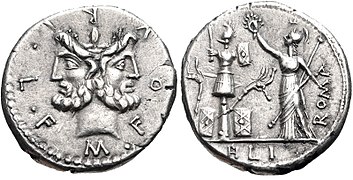










![102 BC, L. Cassius Caecianus (Ceres/yoke of Oxen).[36]](http://upload.wikimedia.org/wikipedia/commons/thumb/5/5b/L._Cassius_Caecianus%2C_denarius%2C_102_BC%2C_RRC_321-1.jpg/364px-L._Cassius_Caecianus%2C_denarius%2C_102_BC%2C_RRC_321-1.jpg)


![c.100 BC, M. Servilius (Roma/Pulex Geminus duelling).[37]](http://upload.wikimedia.org/wikipedia/commons/thumb/9/9f/M._Servilius_C.f.%2C_denarius%2C_c.100_BC%2C_RRC_327-1.jpg/360px-M._Servilius_C.f.%2C_denarius%2C_c.100_BC%2C_RRC_327-1.jpg)


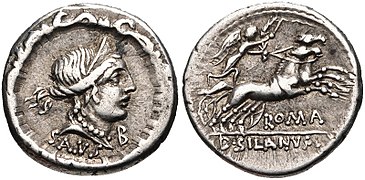



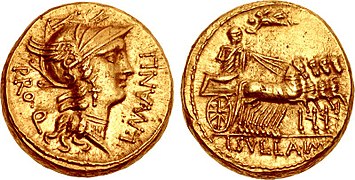
![82-80 BC, , C. Servilius Vatia (Apollo, lituus behind/Pulex Geminus fighting).[38]](http://upload.wikimedia.org/wikipedia/commons/thumb/3/30/C._Servilius_Vatia%2C_denarius%2C_82-80_BC%2C_RRC_370-1b.jpg/369px-C._Servilius_Vatia%2C_denarius%2C_82-80_BC%2C_RRC_370-1b.jpg)











![82-80 BC, , C. Servilius (Flora, lituus behind/Pulex Geminus fighting).[39]](http://upload.wikimedia.org/wikipedia/commons/thumb/9/9d/C._Servilius_C.f.%2C_denarius%2C_53_BC%2C_RRC_423-1.jpg/389px-C._Servilius_C.f.%2C_denarius%2C_53_BC%2C_RRC_423-1.jpg)




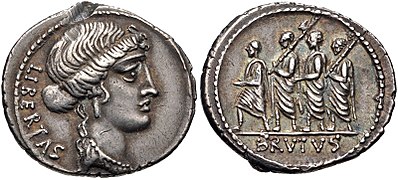
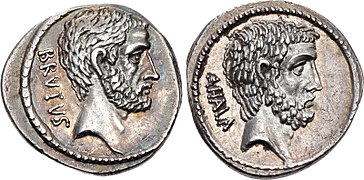







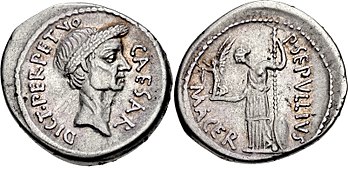
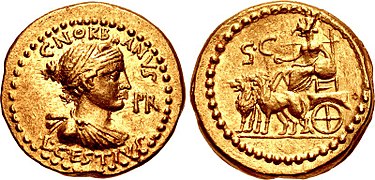




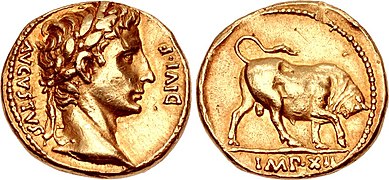
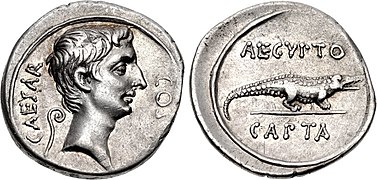



![17 BC, M. Sanquinius (Caesar, with Comet above/Herald of the Ludi Saeculares).[40]](http://upload.wikimedia.org/wikipedia/commons/thumb/8/8a/M._Sanquinius%2C_denarius%2C_17_BC%2C_RIC_I_340.jpg/381px-M._Sanquinius%2C_denarius%2C_17_BC%2C_RIC_I_340.jpg)
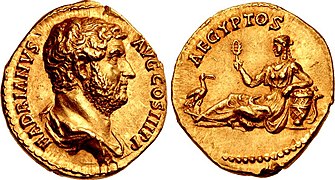







![AD 139, with Aurelius Caesar.[41]](http://upload.wikimedia.org/wikipedia/commons/thumb/2/2c/Antoninus_Pius%2C_with_Marcus_Aurelius_Caesar%2C_denarius%2C_AD_139%2C_RIC_III_412a.jpg/371px-Antoninus_Pius%2C_with_Marcus_Aurelius_Caesar%2C_denarius%2C_AD_139%2C_RIC_III_412a.jpg)
![AD 140-144, showing the betrothal of Aurelius and Faustina in 139.[42]](http://upload.wikimedia.org/wikipedia/commons/thumb/1/1b/Antoninus_Pius%2C_sestertius%2C_AD_140-144%2C_RIC_III_601.jpg/366px-Antoninus_Pius%2C_sestertius%2C_AD_140-144%2C_RIC_III_601.jpg)
![AD 166, Victoria with shield inscribed VIC PAR.[43]](http://upload.wikimedia.org/wikipedia/commons/thumb/e/ef/Marcus_Aurelius%2C_aureus%2C_AD_166%2C_RIC_III_160.jpg/379px-Marcus_Aurelius%2C_aureus%2C_AD_166%2C_RIC_III_160.jpg)
![AD 161-180, pile of German trophies.[44]](http://upload.wikimedia.org/wikipedia/commons/thumb/e/e2/Marcus_Aurelius%2C_aureus%2C_AD_161-180%2C_RIC_III_362.jpg/361px-Marcus_Aurelius%2C_aureus%2C_AD_161-180%2C_RIC_III_362.jpg)
![AD 16, medallion, Jupiter between Aurelius and Verus.[45]](http://upload.wikimedia.org/wikipedia/commons/thumb/d/d8/Marcus_Aurelius%2C_AE_medallion%2C_AD_168%2C_Gnecchi_II_52.jpg/382px-Marcus_Aurelius%2C_AE_medallion%2C_AD_168%2C_Gnecchi_II_52.jpg)
![AD 202, Septimius/Geta (right), Julia Domna (centre), Caracalla (left).[46]](http://upload.wikimedia.org/wikipedia/commons/thumb/8/8e/Septimius_Severus%2C_Julia_Domna%2C_Caracalla%2C_Geta%2C_aureus%2C_AD_202%2C_RIC_IV_181c.jpg/386px-Septimius_Severus%2C_Julia_Domna%2C_Caracalla%2C_Geta%2C_aureus%2C_AD_202%2C_RIC_IV_181c.jpg)

